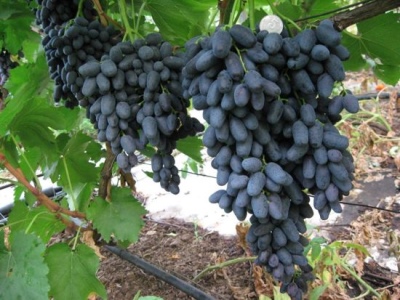
- Authors: Italy
- Appointment: dining room
- Berry color: dark blue, with a prune bloom
- Taste: harmonious, light nutmeg
- Ripening period: early middle
- Ripening period, days: 115-125
- Frost resistance, ° C: -23
- Name synonyms: Vitroblack, Ophelia (Ophelia), Alyonushka raisins, Black Finger type, Black Finger Kishmish
- Bunch weight, g: 800
- Flower type: bisexual
There are a lot of varieties of seedless grape varieties. They are very popular for their taste. There is a lot of discussion among winegrowers about the peculiarities of one of them - the Black Finger variety.
Breeding history
The history of this variety is mysterious. Many confuse it with the work of Israeli scientists - the Black finger grape. In fact, the authors of this wonderful variety are Italian specialists in the field of selection and agriculture, whose goal was to create seedless grapes for table use. It is not known exactly how the breeders got the Black Finger, but, most likely, its origins originate from the Asian roots of the Vitis Winifer species.
Some vineyard owners know this variety by different names, which also adds to the confusion. He hides under synonyms: Vitroblack, Black Finger type and simply Kishmish Black Finger. Many are familiar with the fabulous name of kishmish Alyonushka, as well as the Shakespearean version of Ophelia (Ophelia). The latter name is also patented.
Description
Vine bushes are characterized by increased vigor. At the same time, short internodes are considered a characteristic feature of the Black Finger vine.
Bunches of Black Finger are admirable. The variety belongs to raisins. Inside the berry, soft rudimentary seeds (1-2 pieces) are found, but they are practically not felt during use. If gibberellin treatment is used during cultivation, then there are no seeds, at all.
Due to its excellent transportability, the grapes of this variety, even during long-term transportation, perfectly retain their external attractiveness and presentation.
Ripening period
In its historical homeland, the variety is considered early. In Ukraine and in the south of the Russian Federation, Black Finger has an early to medium ripening period. The growing season is 115-125 days.
Bunches
The bunches of the Black Finger are beautiful, very appetizing in appearance. They are cone-shaped, with noticeable asymmetry. The grapes are harvested at a moderate density. The weight of the bunch is about 800 g, some of them reach more than 1 kg.
Berries
Beautiful large berries, slightly pointed towards the outer edge (about 26 mm wide, 30 mm long), dark blue, with a slight bluish tinge. From above they are covered with pruin, which gives a special velvety skin to the touch. The average weight of the grapes is 6-8 g. The weight of some berries can reach 12 g. The shape is oval-ovoid.
Taste
Under the skin of medium thickness there is a fleshy, very juicy pulp with a combination of harmonious and light nutmeg flavor. The juice is lightly colored.
Yield
High yield variety. But for abundant fruiting, the bush needs to acquire well-formed wood. This can take up to 5 years.


Growing features
Black Finger prefers sunny, very well-lit places on the site. This is the key to active growth and good fruiting. The vine of this variety ripens for a long time, the process is faster in regions with a hot climate. The site must be protected from the wind.
To obtain a pulp, in which stone formations will be completely absent, treatment with a growth activator (gibberellin) is carried out during mass flowering. Use a solution with a substance concentration of 30 mg / l. After 2 weeks, the procedure is repeated.
Landing
It is preferable to choose places where there is no closely located groundwater.
Vines can be formed using the ceiling method (on an arch, arbor) or using ordinary trellises. This will help to form a bush of the required shape, provide access to sunlight to all parts of the plant.

Pollination
The Black Finger variety does not require additional pollination, since its flowers are bisexual.
Pruning
To get a good harvest, it is necessary to form the bush correctly. This is a prerequisite for good vine growth. The main pruning should be done in the fall. The long pruning method is used, leaving from 10 to 12 eyes.
It is also necessary to carefully sanitize, removing damaged shoots.

Watering
The variety is undemanding to abundant watering, but it is also not worth allowing a crust to form on the ground.
Watering is necessary if the weather is hot and dry. Watering with warm water. Each bush requires a bucket of water. Water once a week, less often. If it rains, watering is not required and even dangerous, due to the weak resistance of the variety to fungal diseases.


Frost resistance and the need for shelter
Requires shelter for the cold season. The frost resistance of the variety is low. Lowering the temperature to 23 degrees below zero is detrimental to Black Finger grapes. Better not to use ground cover. This method can provoke the appearance of fungal diseases.

Diseases and pests
Black Finger has low disease resistance. The score on a ten-point system is only 3.5. First of all, it is affected by fungal diseases: mildew, oidium, anthracnose. This is a significant disadvantage of this variety. Timely preventive fungicide treatments are required.
Bunches of grapes of this variety practically do not damage wasps.

If a grape is exposed to any disease or insect, this always affects its appearance.
Storage
It is better to consume Black Finger immediately after collection. It is not stored for long, about 4 months. Hanging the collected bunches is considered a well-demanded storage method. Dry and cool rooms are suitable: cellar, basement.











































































